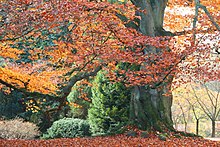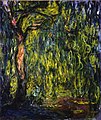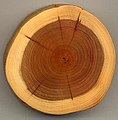The Trees Portal

In botany, a tree is a perennial plant with an elongated stem, or trunk, usually supporting branches and leaves. In some usages, the definition of a tree may be narrower, including only woody plants with secondary growth, plants that are usable as lumber or plants above a specified height. In wider definitions, the taller palms, tree ferns, bananas, and bamboos are also trees.
Trees are not a monophyletic taxonomic group but consist of a wide variety of plant species that have independently evolved a trunk and branches as a way to tower above other plants to compete for sunlight. The majority of tree species are angiosperms or hardwoods; of the rest, many are gymnosperms or softwoods. Trees tend to be long-lived, some trees reaching several thousand years old. Trees evolved around 370 million years ago, and it is estimated that there are around three trillion mature trees in the world currently.
A tree typically has many secondary branches supported clear of the ground by the trunk, which typically contains woody tissue for strength, and vascular tissue to carry materials from one part of the tree to another. For most trees the trunk is surrounded by a layer of bark which serves as a protective barrier. Below the ground, the roots branch and spread out widely; they serve to anchor the tree and extract moisture and nutrients from the soil. Above ground, the branches divide into smaller branches and shoots. The shoots typically bear leaves, which capture light energy and convert it into sugars by photosynthesis, providing the food for the tree's growth and development.
Trees usually reproduce using seeds. Flowering plants have their seeds inside fruits, while conifers carry their seeds in cones, and tree ferns produce spores instead.
Trees play a significant role in reducing erosion and moderating the climate. They remove carbon dioxide from the atmosphere and store large quantities of carbon in their tissues. Trees and forests provide a habitat for many species of animals and plants. Tropical rainforests are among the most biodiverse habitats in the world. Trees provide shade and shelter, timber for construction, fuel for cooking and heating, and fruit for food as well as having many other uses. In much of the world, forests are shrinking as trees are cleared to increase the amount of land available for agriculture. Because of their longevity and usefulness, trees have always been revered, with sacred groves in various cultures, and they play a role in many of the world's mythologies. (Full article...)

Alloxylon flammeum, commonly known as the Queensland tree waratah or red silky oak, is a medium-sized tree of the family Proteaceae found in the Queensland tropical rain forests of northeastern Australia. It has shiny green elliptical leaves up to 18 cm (7.1 in) long, and prominent orange-red inflorescences that appear from August to October, followed by rectangular woody seed pods that ripen in February and March. Juvenile plants have large (up to 25 cm (9.8 in) long) deeply lobed pinnate leaves. Previously known as Oreocallis wickhamii, the initial specimen turned out to be a different species to the one cultivated and hence a new scientific name was required. Described formally by Peter Weston and Mike Crisp in 1991, A. flammeum was designated the type species of the genus Alloxylon. This genus contains the four species previously classified in Oreocallis that are found in Australasia.
Alloxylon flammeum is a canopy or emergent tree of the Mabi rainforest community of north Queensland. Its terminal tubular flowers indicate that the species is pollinated by birds. Readily adaptable to cultivation, Alloxylon flammeum prefers a site with good drainage and responds well to extra moisture and fertilisers low in phosphorus. It is listed nationally as vulnerable under the Australian Environment Protection and Biodiversity Conservation Act 1999 (EPBC Act) as most of its habitat has been cleared for agriculture and logging. (Full article...)
Did you know? -
- ... that the Easter egg tree (pictured) in Saalfeld, Thuringia, was decorated with 10,000 Easter eggs in 2012?
- ... that the Living Willow Theatre, an open air theatre constructed of living willow trees, is located near the village of Llanwrthwl and occasionally holds outdoor performances of Shakespeare?
- ... that Wollemi Stringybark, a tree that grows to 45 metres (148 ft) high northwest of Sydney, remains officially undescribed?
- ... that Linton Park in Kent, England, has an avenue of Giant Sequoia trees planted in 1864?
- ... that the Eduardo Avaroa Andean Fauna National Reserve contains a "stone tree"?
- ... that the scarlet honey myrtle, an ornamental garden shrub, is from the same genus as the punk tree?
- ... that the towers of architect Terunobu Fujimori's Lamune Onsen have pine trees planted on the apex of their roofs?
Selected article -
Beech (Fagus) is a genus of deciduous trees in the family Fagaceae, native to subtropical (accessory forest element) and temperate (as dominant element of mesophytic forests) Eurasia and North America. There are 14 accepted species in two distinct subgenera, Englerianae Denk & G.W.Grimm and Fagus. The subgenus Englerianae is found only in East Asia, distinctive for its low branches, often made up of several major trunks with yellowish bark. The better known species of subgenus Fagus are native to Europe, western and eastern Asia and eastern North America. They are high-branching trees with tall, stout trunks and smooth silver-grey bark.
The European beech Fagus sylvatica is the most commonly cultivated species, yielding a utility timber used for furniture construction, flooring and engineering purposes, in plywood, and household items. The timber can be used to build homes. Beechwood makes excellent firewood. Slats of washed beech wood are spread around the bottom of fermentation tanks for Budweiser beer. Beech logs are burned to dry the malt used in some German smoked beers. Beech is also used to smoke Westphalian ham, andouille sausage, and some cheeses. (Full article...)
General images
Selected lists
Subcategories
Related portals
Associated Wikimedia
The following Wikimedia Foundation sister projects provide more on this subject:
-
 Commons
Commons
Free media repository -
 Wikibooks
Wikibooks
Free textbooks and manuals -
 Wikidata
Wikidata
Free knowledge base -
 Wikinews
Wikinews
Free-content news -
 Wikiquote
Wikiquote
Collection of quotations -
 Wikisource
Wikisource
Free-content library -
 Wikispecies
Wikispecies
Directory of species -
 Wikiversity
Wikiversity
Free learning tools -
 Wiktionary
Wiktionary
Dictionary and thesaurus
-

-

-

-

-
Random portal


















































































You must be logged in to post a comment.